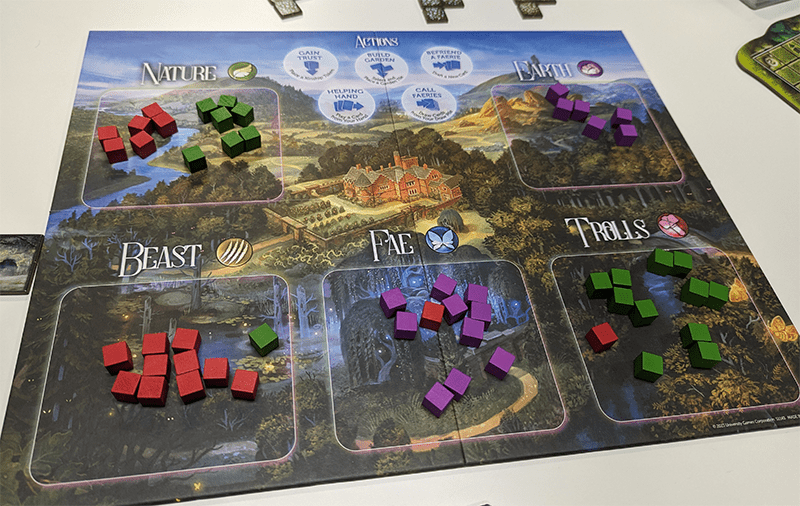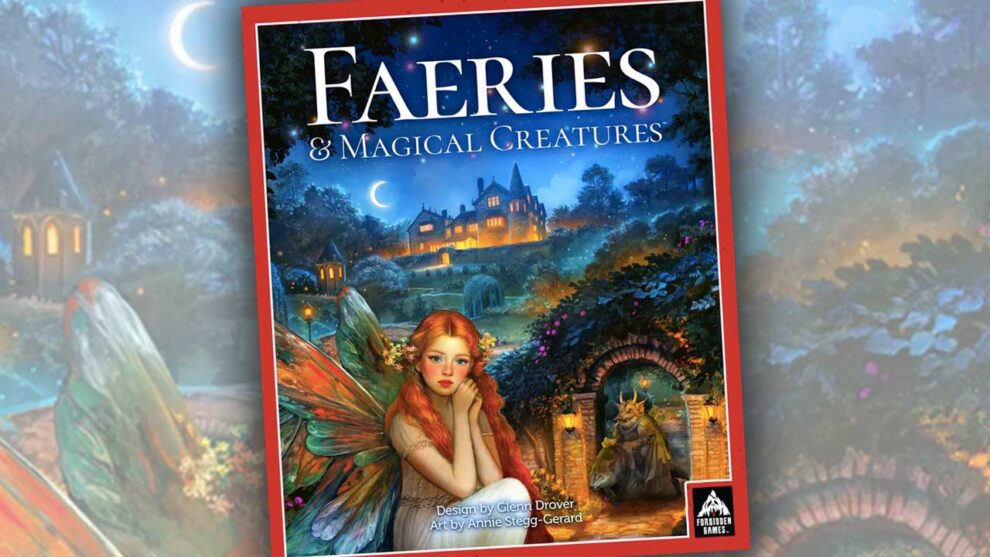As a red-blooded Canadian masculine man, one would easily assume that the only games I would be interested in reviewing are games about violence like war, hockey, and Tim Hortons takeout. But I’m a simpler man than that. Sometimes good artwork and a few key phrases like “deckbuilder” and “area control” will hook my curiosity like a fish on a line. Admittedly, while this particular game involves tile placement, a genre I don’t typically favor, I’ve come to recognize that in any healthy relationship, there’s room for compromise.
Faeries & Magical Creatures presents a straightforward game with a clear storyline. You and your companions are hanging out in a family summer home when you catch a glimpse of a faerie. After this brief magical encounter, you decide to commit the rest of your summer to getting to know these whimsical creatures. Your goal is to build trust with the faeries, call them out when you spot them, and create a garden oasis to attract them.
That sounds like a lot of tasks, but fortunately, this game has an easy ruleset. On your turn, you pick one of five actions. You perform that action, as does everyone else, with the exception that you have the added benefit of playing a card from your hand either before or after your action to gain an advantage. These actions involve selecting a garden tile from the available options, acquiring a faerie card from the offering, playing a card, drawing cards, or placing a kinship token in one of the five designated areas.
Building Your Faerie Sanctuary
The five areas on the board represent the five different types of magical creatures, such as fae, beasts, and trolls. From a game mechanics perspective, there isn’t any difference between the five spaces, but they are vital for scoring.
At the end of the game, you check each area. If you have the most kinship tokens in an area, you score a point for every single cube, including your opponents’ cubes. In second place, you count your own cubes. That notion alone appears highly competitive, but it becomes even more intense when you place ten kinship tokens. Once you reach that magic number in one of the five areas, you’ll gain that creature type’s home tile that you can place in your garden.
You have your own personal grid garden board with some icons. When you grab a tile from the offering, you immediately place it on your grid, and if you cover icons, you get a benefit. These benefits range from gaining victory points, drawing a card, or placing a kinship token. An important feature of the tiles is that they are double-sided, with one side being the plant and the other one being the path side. On the plant side, you can place it anywhere with no restrictions, while the path side requires you to constantly connect with the previous path tile, and the starting path tiles must be at the edge of the board.
The trick with laying garden tiles is that at game end, you can only score plant tiles that connect to the path tiles. This creates a balancing act: you want to place plants to gain early benefits, but ensure they ultimately connect to the paths for points. Properly plotting your garden while handling other actions is key. Your goal is to weaponize tile placement for advantages now while setting up scoring later. This is where the home tiles come in—having a creature’s home in your garden doubles the value of the surrounding plant tiles. With this multiplier effect, home tiles become pivotal to victory. You’ll need to keep an eye on the game’s end timer while crafting your garden masterpiece.
This cycle repeats until someone runs out of kinship tokens, the card or tile supply is exhausted, or all five home tiles have been claimed. The game ends when one of these conditions is met. At that point, players calculate their final scores based on their garden connectivity and the five areas. The player with the highest total score wins the game.

Bewitching Balancing Act
Before I go into details about my impressions, I need to state that I am looking at this game through the lens of a family game, not a typical hobbyist game. It’s quite clear from the marketing material, such as photos of children smiling or video trailers of a family playing this game, that this isn’t meant for the type of people that rate a game 1 on BoardGameGeek without playing it because of “AI art,” “negating the 10s,” or “offensive theme.”
That’s why I was completely stunned by the intense competitiveness of this “family” game. It’s unhesitant in its approach to sinking its teeth in and making you bleed a bit. There’s a significant amount of player engagement as everyone vies for control over territories and cards. It’s one of the rare family games where my friends and I deliberate our post-game tactics for a good five minutes. I didn’t anticipate that level of depth.
I’ll be honest, when I first saw Faeries & Magical Creatures listed as a deckbuilder, tile placement, and area control game all in one box, it raised my skepticism. Usually when a game tries to mash up too many genres, it ends up a disjointed mess—I’m looking at you, Tapestry. However, in the case of Faeries & Magical Creatures, the different elements blend together surprisingly well.
Deckbuilding involves improving your hand of rule-breaking cards. The tile placement aspect of path connectivity creates an intriguing spatial puzzle. And the area control race for kinship tokens adds interactive competition. Rather than feeling tacked on, the various mechanics create a cohesive experience where each part complements the others in one direction, like a stream eroding through my doubts.
An Enchanting Engine
An easy piece of evidence I could point to is the relationship between the area control and the garden. As I’ve mentioned before, there are icons in the garden that give you benefits, and a good chunk of them are the kinship tokens. Cover them, and you immediately place a kinship token in one of the five areas, accelerating your race to get ten so you can get that home tile back into your garden.
And you are going to pay attention to area control. I’m usually a fan of vying for map control, but even I was surprised by just how brutal the battle for kinship tokens can be. You score points for every single cube in an area—yours AND your opponents. This means token placement becomes a relentless calculus of optimization and denial. You need to maximize your own cubes while minimizing what your rivals can score. It drowns you in so many razor-sharp decisions that even a cunning Kelpie would be impressed and start taking notes.
If there was one area of the game where I do have a bit of an issue, it’s the deckbuilding. When we often hear the word “deckbuilder,” we immediately invoke images in our heads about numerous cards being played and creating elaborate combinations. That doesn’t apply here. This isn’t Dominion or Clank. At most, you will play one or two cards, and they are simple effects mainly used to modify your chosen action. Many of them are variants of other basic actions.
This isn’t to give the impression that picking cards isn’t important. You’ll learn quickly that grabbing the right cards to improve your positioning in certain areas of the game is essential. If you plan on abusing garden tiles, recruit a Nymph to grab more tiles. Playing the area control game will force you to enlist cards that allow you to place kinship tokens or remove your opponent’s kinship tokens, leading to more tears than an alimony hearing. There are also plenty of cards that reward you with victory points, such as every two kinship tokens in a specific area or filling out a column at the garden, giving you personal objectives to pursue.

Casting Competitive Spells
While it sounds like I’m describing a cruel competitive game under the guise of beautiful artwork, the gameplay never feels unfair or punitive. Since all players perform the same set of actions each turn, everyone progresses forward together, and downtime is as mythical as these creatures. No one falls too far behind in tiles placed, cards collected, or tokens grabbed. Rather than ruthless blocking, the challenge is optimizing your own strategy and eking out small advantages. The question the game is constantly asking you is if you are progressing in the right direction.
Which is why I am so frustrated that this is also one of the most unpolished games I’ve come across in a long time. The worst part is that you won’t even notice that at first glance. How could you? The box attracts you with its bright red border and award-winning artwork. Open up the box, and you are introduced to a carefully crafted plastic insert with linen-finish components that look and feel great. A quick peek at the rulebook shows that this game will be easy to teach. That is, until you squint at the details.
Details like, what if there is a tie for the area control? What if you cannot place a home tile in your garden? The card says “count this type of card in your draw pile and score VP,” so do I reshuffle my draw pile afterwards? The Nymph card states I take two garden tiles, pick one, so how is this done? When scoring a card played for “VP per card in hand”, do you count the played card in the total?
Mischievous Rulebook
None of these questions are answered in the rulebook. No card clarifications, no FAQ, or anything of that sort. It is sparse with detail, and that’s simply not acceptable for a family game. A family getting into board games likely isn’t going to browse board game Reddit, BoardGameGeek, or Kickstarter for rule clarification. They probably don’t even know what Kickstarter is. I’m surprised I am bringing this up because this is the same designer and company behind Raccoon Tycoon, a game with a rulebook that is more solid than the Great Wall of China.
I also try to avoid harping on balance in reviews since it can be subjective, but in Faeries & Magical Creatures, one particular unicorn card is objectively overpowered. It scores you 2 victory points per token in the area with the fewest cubes. Compared to other point cards that max out around 5 points after much effort, this unicorn can easily net 10+ points for no work, and it gets exponentially stronger the more players there are. I’ve seen it single-handedly swing games, and after multiple playthroughs, I finally removed it from the deck entirely.
Even with a few fuzzy rules and some balancing problems, Faeries & Magical Creatures still ranks as one of the most enjoyable and immersive family-friendly games I’ve tried in 2023. Its straightforward setup gets you into the action within minutes. Turns zoom by, thanks to shared actions, leaving little room for boredom. The rules are a breeze to explain, catering to players of all skill levels, and each turn presents unexpectedly engaging choices, adding a layer of satisfying strategy without overwhelming you. Altogether, it creates a laid-back yet captivating gaming experience for entry-level gamers. Despite a couple of rough edges, Faeries & Magical Creatures shines brightly for embracing high-interactive gameplay in a hobby often afraid of direct conflict.












This sounds amazing! I will have to delve into this one and see if this is a game I can get my group to try.
Thanks for a wonderful review!